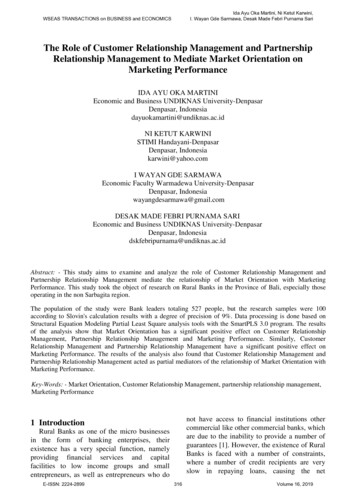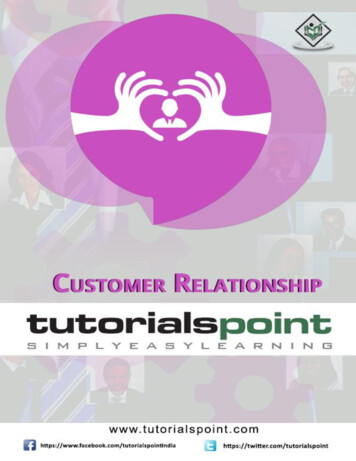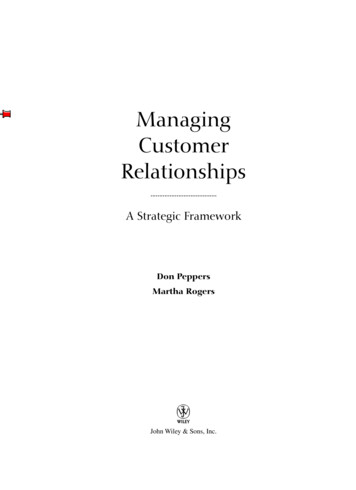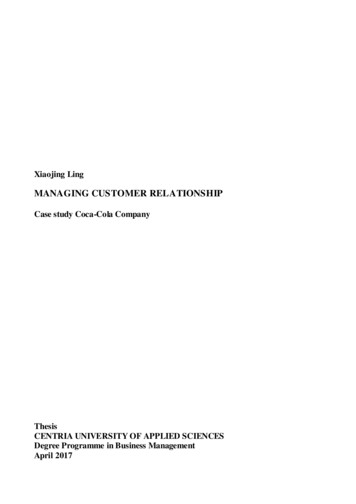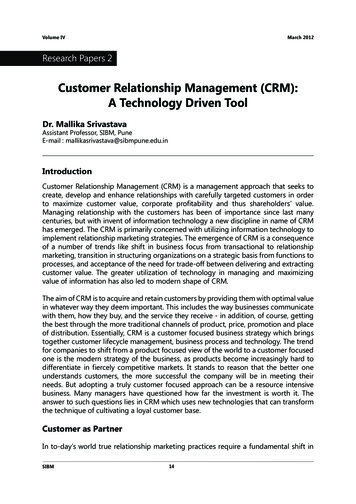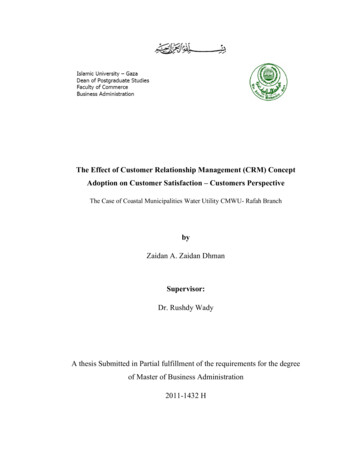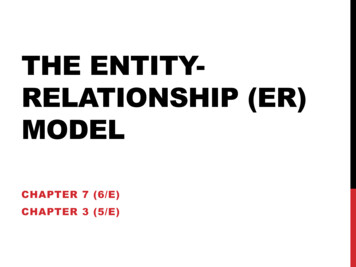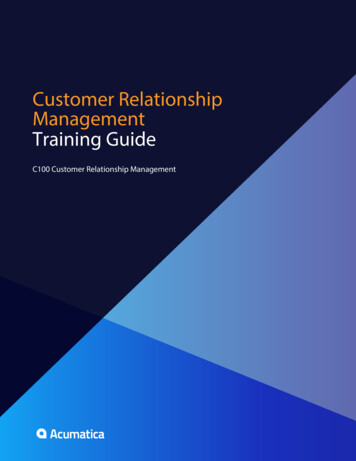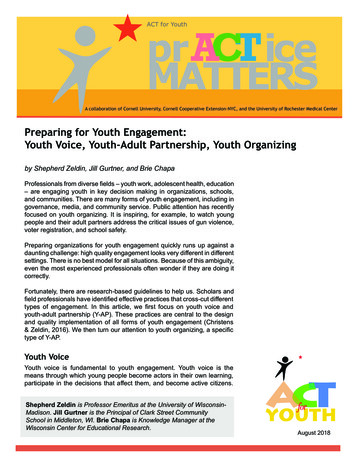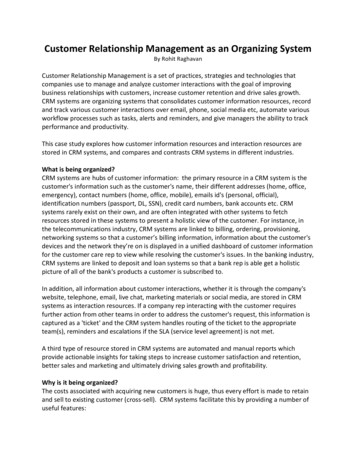
Transcription
Customer Relationship Management as an Organizing SystemBy Rohit RaghavanCustomer Relationship Management is a set of practices, strategies and technologies thatcompanies use to manage and analyze customer interactions with the goal of improvingbusiness relationships with customers, increase customer retention and drive sales growth.CRM systems are organizing systems that consolidates customer information resources, recordand track various customer interactions over email, phone, social media etc, automate variousworkflow processes such as tasks, alerts and reminders, and give managers the ability to trackperformance and productivity.This case study explores how customer information resources and interaction resources arestored in CRM systems, and compares and contrasts CRM systems in different industries.What is being organized?CRM systems are hubs of customer information: the primary resource in a CRM system is thecustomer's information such as the customer's name, their different addresses (home, office,emergency), contact numbers (home, office, mobile), emails id's (personal, official),identification numbers (passport, DL, SSN), credit card numbers, bank accounts etc. CRMsystems rarely exist on their own, and are often integrated with other systems to fetchresources stored in these systems to present a holistic view of the customer. For instance, inthe telecommunications industry, CRM systems are linked to billing, ordering, provisioning,networking systems so that a customer’s billing information, information about the customer'sdevices and the network they’re on is displayed in a unified dashboard of customer informationfor the customer care rep to view while resolving the customer's issues. In the banking industry,CRM systems are linked to deposit and loan systems so that a bank rep is able get a holisticpicture of all of the bank's products a customer is subscribed to.In addition, all information about customer interactions, whether it is through the company'swebsite, telephone, email, live chat, marketing materials or social media, are stored in CRMsystems as interaction resources. If a company rep interacting with the customer requiresfurther action from other teams in order to address the customer's request, this information iscaptured as a 'ticket' and the CRM system handles routing of the ticket to the appropriateteam(s), reminders and escalations if the SLA (service level agreement) is not met.A third type of resource stored in CRM systems are automated and manual reports whichprovide actionable insights for taking steps to increase customer satisfaction and retention,better sales and marketing and ultimately driving sales growth and profitability.Why is it being organized?The costs associated with acquiring new customers is huge, thus every effort is made to retainand sell to existing customer (cross-sell). CRM systems facilitate this by providing a number ofuseful features:
1. Contact Center Automation - CRM systems automate some of the tasks performed byhuman agents by providing pre-recorded audio assists and IVR (interactive voice response)prompts that help the customer in problem-solving and information dissemination. If thesystem is not able to resolve the customer's problem, the call is routed to an appropriatehuman agent who is qualified to handle the problem. The system also handles routing ofthe customer problem 'tickets' to multiple agents until the problem is resolved, all the whilekeeping track of SLA and notifying the customer of any updates.2. Marketing Automation - CRM systems automate marketing efforts to potential and existingcustomers by identifying specific customer requirements and suggesting alternatives orenhancements. The system can then automatically send them targeted marketing materialswith the goal of turning a sales lead into a full-fledged customer.3. Sales force Automation - CRM systems keep track of all contact and follow-ups between acompany salesperson and a customer. Using customer information resources and usagepattern resources, CRM systems can identify and target profitable customers. CRM systemsanticipate and time sales efforts based on historic trends of high sales.How much is it being organized?CRM systems store all customer information resources at a granular level - names, addresses,identification numbers, bank and credit card details, income range, job title etc. In case ofbusiness or enterprise customers, information about the type of organization and number ofemployees are also stored.Details of every interaction between a customer rep and customer, regardless of channel, arecaptured as interaction resources. The level of granularity of details of interaction resources isdependent on the CRM implementation. Often businesses require very granular data in specificfields for interactions which require a follow up ‘ticket’ in order to automate the process ofrouting of tickets to appropriate team(s) for handling. Interaction resource data include a titleor reason, description, priority or severity, and SLA depending on the reason and priority.In addition, the CRM systems may fetch resources from other integrated systems, for instanceusage patterns which is a type of interaction resource is retrieved from other systems to displaya holistic picture of the customer to the company rep. This interaction resource is used ingenerating reports or for predictive analysis in order to better understand customer needs andcater to them. For instance, telecommunication companies and banks may use interactionresources to better tailor existing products to their customers’ needs and suggest additionalproducts that the customer may be interested in.When is it being organized?Most of the organization of customer information resources in CRM systems is done "on theway in" i.e when a lead is generated, when the lead is converted into a customer, or when thecustomer orders additional products - all these events lead to customer information resourcesbeing created in CRM systems. Interactions between customers and customer reps arecaptured as interaction resources when the interaction takes place. Resources from otherintegrated systems may be fetched in real time or in batches for the purpose of viewing, or they
may be consolidated into customer information resources and stored for report generationand/or predictive analysis. Reports and analysis are run periodically or on an on-demand basis.A resource purging policy is defined due to legal or privacy reasons, where interactionresources older than a specified time is deleted.Who (or what) is organizing it?Resources in CRM systems are saved in relational databases according to a predefined schema.The customer information resource schema is decided during the implementation of the CRMsystem based on business requirements of capturing data in sufficient granularity. Customerinformation resource instances are created automatically in the case of online customercreation or manually by store or customer care reps when a lead is converted to a customer instores or in a call center. Interaction resources are created on the fly when an interaction eventoccurs between a company representative and a customer.Where is it being organized?Organization and storage of customer information resources and interaction resources in CRMsystems happen in the cloud for could-based CRM deployments or on company premises whenthere are security and privacy constraints.ArtifactsTo better understand CRM as an Organizing System in terms of how resources are organizedwithin CRM and linked to resources in External systems, two class diagrams of CRM systems intelecommunications and banking industries are provided to contrast the differences.In addition, two important flows of CRM systems: Customer Orders Product (COP) andCustomer has Question (CHQ) are described through swimlane diagrams.
1. Class Diagram of CRM in Telecommunications Industry2. Class Diagram of CRM in Banking Industry
3. Swimlane Diagram of Customer Orders Product (COP) Flow
4. Swimlane Diagram of Customer Has Question (CHQ) Flow
Customer Relationship Management as an Organizing System By Rohit Raghavan Customer Relationship Management is a set of practices, strategies and technologies that companies use to manage and analyze customer interactions with the goal of improving business relationships with customers, increase
